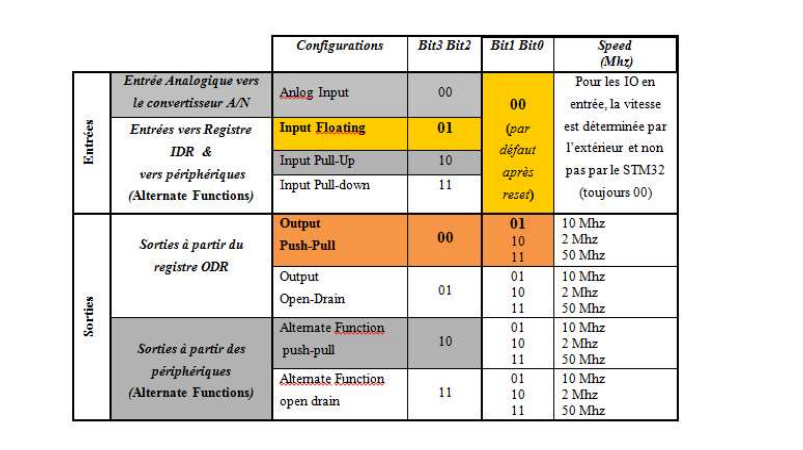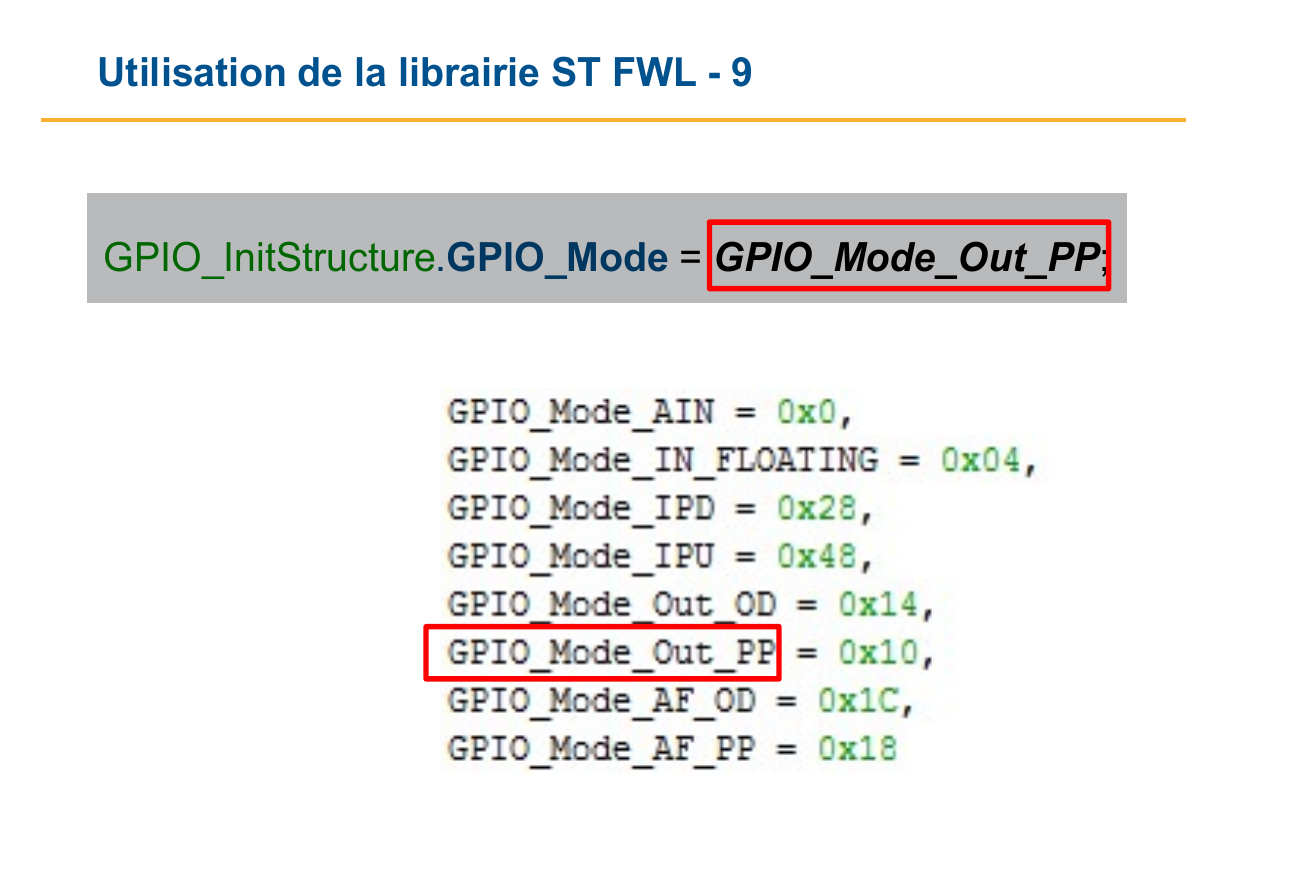Cheat sheet
General Input Output
Define registry
#define Reg_name (type_data*) adr;
// example : registry spanning 8 bits , starting on address 0x300
#define PortA (uint8_t*) 0x300;
Write to a registry
#define PortA (uint8_t*) 0x300;
*PortA = 0x0FF;
read from registry
#define PortA (uint8_t*) 0x300;
int a = *PortA;
Bitwose Not
~ 0x34 != ~ 0x00000034;
~ (unit32_t) 0x34 == 0x00000034
right to left shift
int a = 0x01 << 8
a == 0x0100
Chapter 2 : STM32
RCC: Reset Control Clock
Is a module responsible for enabling / disabling other I/O Peripherals
Base address : 0x4002 1000
GPIO
4 parts :
- Input data register IDR
- Output data register ODR
- Config Register
- 16 I/O ports connected to microcontroller pins
Frequencies :
- 2mhz
- 10mhz
- 50mhz
Config Regsiter :
- CRL : config register low 32 bit each pin is 4 bit
- CRH : config register high 32 bit each pin is 4 bit
How to program GPIO :
- define registries
- activate I/O interfaces ( GPIOx)
- configure GPIO
- impose or read the value of a bit
Example on how to light up a led with GPIOC on pin9 with push-pull
we use 0001 as config
We use CRH cuz 9 > 7
// Le registre du module RCC permettant d’activer les interface E/S
// GPIOA is 2
#define RCC_APB2ENR (uint32_t*) 40021018;
// pin
// Le registre de configuration CRH du port GPIOC
#define GPIOC_CRH (uint32_t*) 0x40011004;
// Le registre ODR du port GPIOC
#define GPIOC_ODR (uint32_t*) 0x4001100C;
// Initialiser le registre RCC_APB2ENR pour activer GPIOC
*RCC_APB2ENR |= 0x00000010;
// set config to 0001
// pin 9 is from 4..7
*GPIOC_CRH &= ~ (((uint32_t)) 0x0F << 4);
*GPIOC_CRH |=0x01 <<4;
// allumer led
// allumer Led : set pin 9 to 1
*GPIOC_ODR|= 0x01 << 9;
// eteindre led : set pin 9 to
*GPIOC_ODR &= ~ ((unit32_t) 0x01 << 9);
Note you can set ODR register values on one go using BSRR and BRR addresses Each BRR and BSRR are unique to each GPIO
set 9th bit to one : *BSRR = 0x1 << 9
set 9th bit to zero : *BRR = 0x1 << 9
Chapter 3 : ST Firmware Library (ST FWL)
Every GPIO address is set as Struct with access to all registries like
- GPIOC->CRH
- RCC->APB2ENR
Program init
GPIO_InitStructure.GPIO_Pin = GPIO_Pin_9 | GPIO_Pin_8 ;
GPIO_InitStructure.GPIO_Speed = GPIO_Speed_2MHz;
GPIO_InitStructure.GPIO_Mode = GPIO_Mode_Out_PP;
GPIO_Init (GPIOx , &GPIO_InitStructure);
GPIO_SetBits : take GPIOx and A pin and sets its to one
example : GPIO_SetBits ( GPIOC, GPIO_Pin_9 | GPIO_Pin_7); ) :
GPIO_ResetBits does the oposite
example : GPIO_ResetBits ( GPIOC, GPIO_Pin_9);
Activate I/O RCC with helper function :
RCC_BUSxPeriphClockCmd ( RCC_BUSxPeriph_PPPx, ENABLE );
example :
RCC_APB2PeriphClockCmd ( RCC_APB2Periph_GPIOA, ENABLE );
Interuptions
INT : An interruption is generated
INTA : an acknologment of interuption
PC : (Program Counter)
IRR : Interrupt Request Register , a value of 1 in a bit indicates if the corresping perif has a request
ISR : In Service registry , Every bit indicates if the corresping interuption is being run (1) or waiting
ISRi : contains the code for periph i
IMR : Interrupt Mask Register , Similit to RCC , activates desactivates interruptions with each bit
IPR : Interrupt Priority Registers , 8 bit 0 -> 256
@ISRi : 4 * i , pointer to ISR i ( for arm it starts at 0x04)
ARM M3
ISERx : Interrupt Set Enable Register (32 bits) : chaque bit de ce registre permet d’autoriser l’interruption correspondante quand il est mis à 1.
ICERx : Interrupt Clear Enable Register (32 bits): chaque bit de ce registre permet d’interdire l’interruption correspondante quand il est mis à 1.
ISPRx : Interrupt Set Pedning Register (32 bits) : La mise à 1 d’un bit de ce registre active (déclenche) une interruption (met l’interruption en état pending). Généralement, ce bit n’est pas mis par software, mais par un périphérique « Figure -1 ».
ICPRx : Interrupt Clear Pedning Register (32 bits) : La mise à 1 d’un bit de ce registre met l’interruption en état ‘not pending’. Ce bit est mis automatiquement à 1 par le matériel (logique de contrôle du NVIC) après avoir commencé l’exécution du Handler associé à l’interruption. Mais, il peut être également accédé par soft.
priorities
ARM has a system of priority and sub-priority
ARM manages the number with of priority groups relative to subgroups with thelp of
NVIC_PriorityGroupConfig ( uint_32t NVIC_PriorityGroup )
// NVIC_PriorityGroup_0 : pour PRIGROUP = 111
// NVIC_PriorityGroup_1 : pour PRIGROUP = 110
// NVIC_PriorityGroup_2 : pour PRIGROUP = 101
// NVIC_PriorityGroup_3 : pour PRIGROUP = 100
// NVIC_PriorityGroup_4 : pour PRIGROUP = 011
ISRi starts at 0x04 for ARM , 0x00 is reserved for MSP Main Stack pointer
We can move the ISRi vector using VTOR (Vector Table Offset Register)
nvic config
uint8_t NVIC_IRQChannel : Il s’agit d’une valeur sur 8 bits qui identifie le numéro de l’interruption à configurer. Ces numéros sont figés matériellement. La liste des sources de requêtes d’interruptions ainsi que leurs numéros pour la famille F1 est donnée à la fin du chapitre « tableau -4 » Remarque : Consulter le document d’aide de la librairie ST pour trouver les valeurs.
uint8_t NVIC_IRQChannelPreemptionPriority : C’est une valeur sur 8 bits indiquant le groupe de priorité auquel appartient l’interruption à configurer « voir tableau 3 ».
uint8_t NVIC_IRQChannelSubPriority : C’est une valeur sur 8 bits indiquant le niveau de priorité attribué à l’interruption au sein du groupe « voir tableau 3 ».
NVIC_IRQChannelCmd : peut prendre la valeur ENABLE (1) pour autoriser l’interruption ou bien DISABLE (0) pour interdire son déclenchement.
typedef struct
{
// attributes
} NVIC_InitTypeDef ;
NVIC_InitTypeDef
NVIC_InitStruct ; // Déclarartion d’une structure de type NVIC_InitTypeDef
NVIC_InitStruct .NVIC_IRQChannel = FLASH_IRQn; // L’identifiant de l’interruption générée par le Flash.
NVIC_InitStruct. NVIC_IRQChannelPreemptionPriority = 15; // Le groupe ayant la priorité la plus basse.
NVIC_InitStruct. NVIC_IRQChannelSubPriority = 0;
// un seul niveau d’interruption est disponible (0).
NVIC_InitStruct. NVIC_IRQChannelCmd = ENABLE; // autoriser l’interruption.
NVIC_Init (&NVIC_InitStruct);
NVIC_Init( & NVIC_InitStruct )
handle interup function
void ........._IRQHandler ( )
{
// Code à exécuter
Periph_ClearITPendingBit();
// Code à exécuter
}
// multiple events
void ........._IRQHandler ( )
{
If ( periph _GetITStatus ( .....FLAG 1 ) )
{ .......
periph_ClearITPendingBit (.....)
}
...............
.................
}
If ( periph_GetITStatus ( .....FLAG N) )
{ .......
periph_ClearITPendingBit (......)
}
Tail Chaining dure que 6 cycles.


